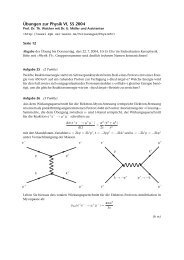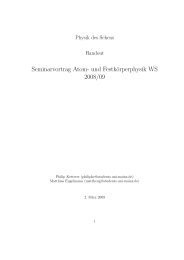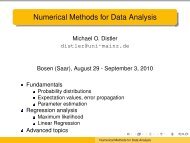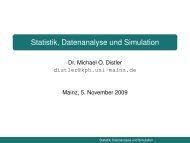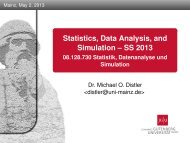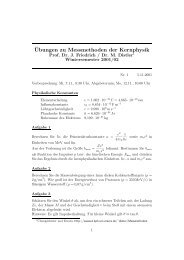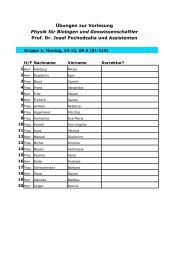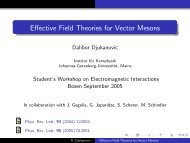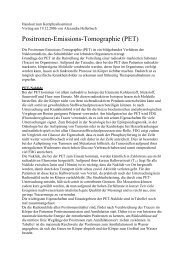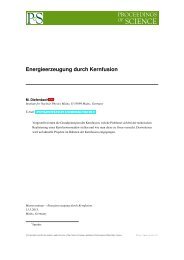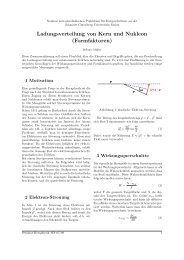A Classic Thesis Style - Johannes Gutenberg-Universität Mainz
A Classic Thesis Style - Johannes Gutenberg-Universität Mainz
A Classic Thesis Style - Johannes Gutenberg-Universität Mainz
Create successful ePaper yourself
Turn your PDF publications into a flip-book with our unique Google optimized e-Paper software.
16 introduction<br />
amount of resonances at first and letting a fit to existing data to decide<br />
which of them were more active in the reaction dynamics. Obviously,<br />
the large number of fitting parameters generates doubts about the<br />
uniqueness of the solution obtained by this method.<br />
Table 1: Model Kaon-Maid for Λ and Σ 0 production. Parameters of assumed<br />
resonances.<br />
resonance (I)J π mass( MeV) width(MeV) g1/v g2/t<br />
K ∗ (892) 1 − 892 50 -0.787 -2.628<br />
K1(1270) 1 + 1273 90 3.810 -2.408<br />
N(1650) S11<br />
N(1710) P11<br />
N(1720) P13<br />
N(1895) D13<br />
∆(1900) S31<br />
1 1 −<br />
2 ( 2 )<br />
1 1 −<br />
2 ( 2 )<br />
1 3 +<br />
2 ( 2 )<br />
1 3 −<br />
2 ( 2 )<br />
3 1 −<br />
2 ( 2 )<br />
−<br />
)<br />
1655<br />
1710<br />
1720<br />
1895<br />
1900<br />
1910<br />
150<br />
100<br />
150<br />
370<br />
200<br />
250<br />
-0.133<br />
-0.258<br />
-0.046<br />
1.101<br />
0.106<br />
0.322<br />
0.000<br />
0.000<br />
-0.614<br />
0.634<br />
0.000<br />
0.000<br />
∆(1910) P31<br />
3 1<br />
2 ( 2<br />
The isobaric model by Bennhold et al. (Kaon-Maid in the following<br />
[33]) uses spin 1/2 and 3/2 s-channel resonances, S11(1650), P11(1710),<br />
P13(1720) and the missing resonance D13(1895) predicted by the constituent<br />
quark model by Capstick and Roberts and calculated to<br />
have a significant KΛ decay width. For K + Σ 0 production, the two<br />
∆-resonances S13(1900) and P13(1910) are added. Phenomenological<br />
form factors are used at the hadron vertexes to account for the high W<br />
region behavior and the Haberzettl method is used to restore gauge<br />
invariance. Kaon resonances K ∗ (890) and K1(1270) are included in the<br />
t channel. No hyperon resonances are used in this model. Coupling<br />
constants are obliged to fulfill the SU(3) constrains explained above.<br />
The Kaon-Maid version used in this thesis was fitted to the older<br />
SAPHIR data [34]<br />
In the original Kaon-Maid model the longitudinal coupling constants<br />
to N ∗ resonances appeared unreasonably large (see table 1), and<br />
cut-off parameters unreasonably small. In addition, some inconsistencies<br />
in convention for the amplitudes in the electromagnetic form<br />
factors in the born terms and in the couplings to spin-3/2 resonances<br />
were found and corrected. A reduced version of the model was defined<br />
by setting these longitudinal couplings to zero.<br />
As an example Fig. 5 shows the contributions of the different resonances<br />
in this reduced version to the total Λ and Σ 0 cross-sections<br />
in our kinematics (See chapter 2). We will also make use of a new<br />
version of Kaon-Maid that uses very small longitudinal couplings. In<br />
this version four nucleon resonances, D15(1675), D13(1700), F15(2000),<br />
and D15(2200) were added to the previous set and the free parameters<br />
of the model were re-fitted to describe the new world data on the



